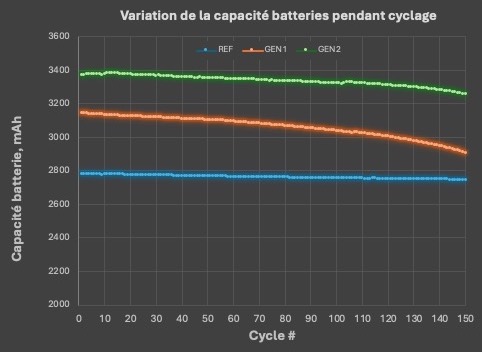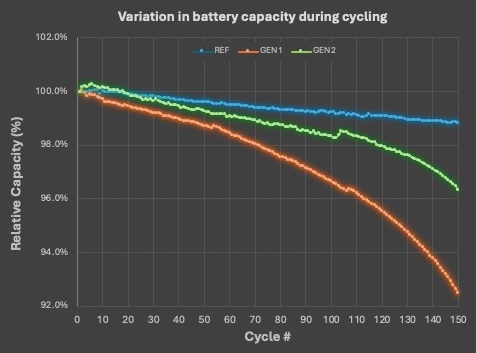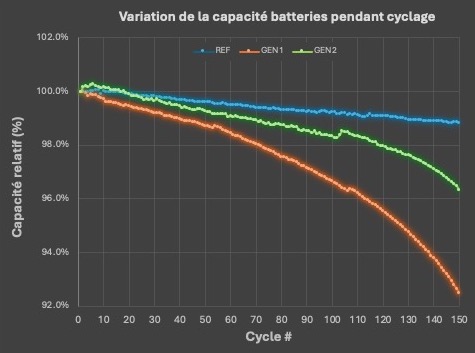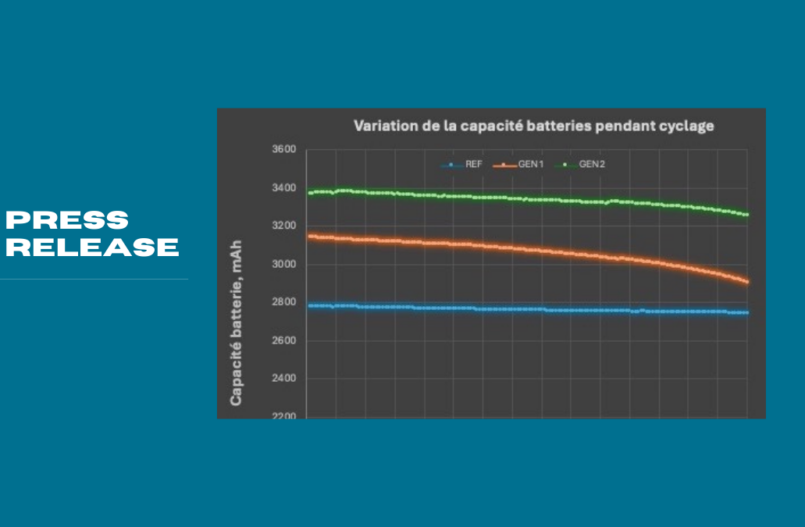- Testing results after 150 cycles show that the GEN2 material batteries maintain strong overall capacity compared to the graphite benchmark and GEN1 material batteries, with significantly lower cycle degradation than GEN1 batteries [1].
MONTREAL, Canada — HPQ Silicon Inc. (“HPQ” or the “Company”) (TSX-V: HPQ) (OTCQB: HPQFF) (FRA: O08), a technology company specializing in green engineering of silica and silicon-based materials is pleased to announce the latest battery milestones achieved by its France-based affiliate, NOVACIUM SAS (“Novacium”).
This announcement highlights the continuation of remarkable results from cycle tests of 18650 industrial batteries made with Novacium’s non-optimized second-generation advanced silicon-based anode material over 150 cycles.
“This continued performance at 150 cycles showcases our understanding of how to produce a blend of graphite and advanced silicon anode material that significantly improves overall battery performance and can be seamlessly integrated into existing anode manufacturing facilities,” stated Dr. Jed Kraiem, Ph.D., COO of Novacium. “Our goal is to continue improving the material so GEN3 exceeds the 4,000 mAh mark.”
SILICON BASED ANODE MATERIALS KEEP ENHANCING BATTERY PERFORMANCE AT 150 CYCLES


la capacité moyenne des batteries GEN1 et la ligne verte montre la capacité moyenne de GEN 2, toutes mesurées en milliampères-heures (mAh) sur 150 cycles [1]
Graph 1 clearly shows the significantly higher capacity over time of batteries made with Novacium GEN2 materials compared to those made with Novacium GEN1 materials and the 100% graphite benchmark batteries.
The average capacity of three 18650 batteries made with Novacium GEN2 materials during the first 150 cycles (green line in the graph) was approximately 3,337.4 mAh, decreasing to 3,256.6 mAh by the 150th cycle.
In comparison, the average capacity of three 18650 batteries made with Novacium GEN1 materials (orange line in the graph) was approximately 3,062 mAh, decreasing to 2,909.7 mAh by the 150th cycle. Finally, the average capacity of three 18650 100% graphite benchmark batteries (blue line in the graph) was approximately 2,763.7 mAh, decreasing to 2,747.6 mAh by the 150th cycle.
SILICON BASED ANODE MATERIALS DELIVERING INTERESTING BATTERY DEGRADATION RESULTS AT 150 CYCLES


la capacité relative des batteries GEN1 et la ligne verte montre la capacité relative des batteries GEN2, sur 150 cycles. [1].
Graph 2 demonstrates the two-fold better capacity retention of batteries made with Novacium GEN2 materials, at 96.3%, compared to those made with GEN1 materials at 92.5% at 150 cycles.
Graph 2 further shows that between the 100 cycles and 150 cycles mark, batteries made with Novacium GEN2 materials had only a 2% measurable cycle degradation (from 98.3% to 96.3%) compared 4.2% measurable cycle degradation (from 96.7% to 92.5%) of the batteries with Novacium GEN1 materials.
While below the benchmark graphite capacity retention of 98.8% at 150 cycles, the 3.7% capacity loss of GEN2 material batteries is still a two-fold improvement compared to the 7.5% capacity loss of GEN1 material batteries.
“These promising results have real-world applications,” stated Mr. Bernard Tourillon, President and CEO of HPQ Silicon Inc. and NOVACIUM SAS. “They clearly indicate that our silicon-based anode materials approach is paying off.”
REFERENCE SOURCES
[1] Novacium technical team analysis of the data from the ongoing charging and discharging cycle tests conducted at a world-leading university, the name of which is kept confidential for competitive reasons.

